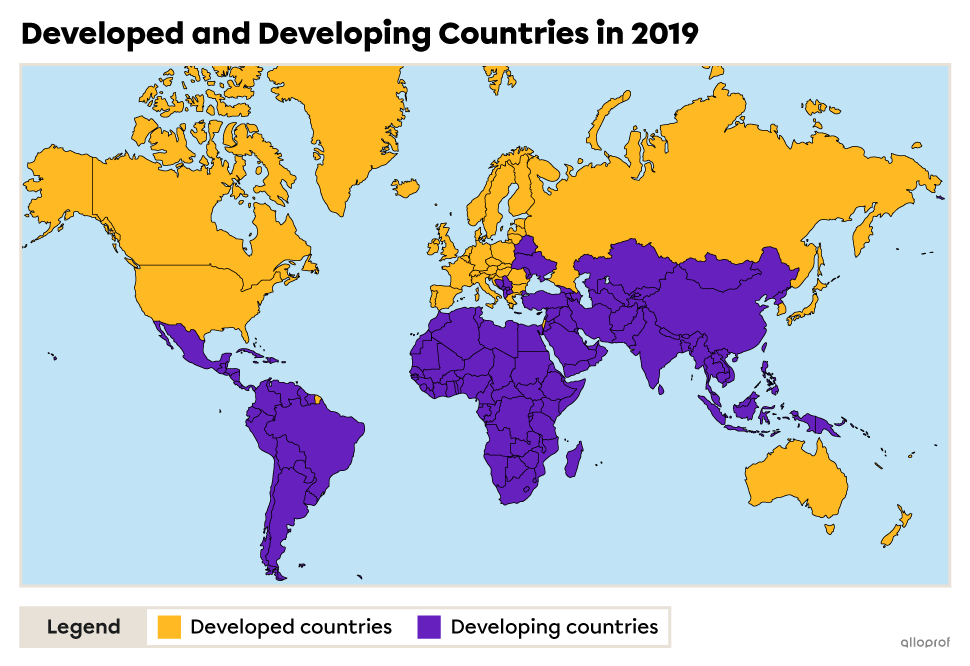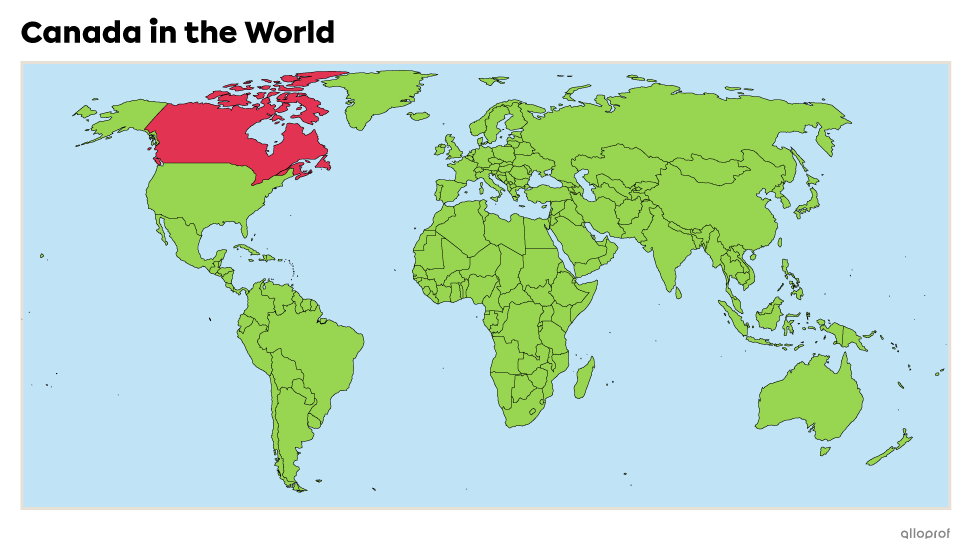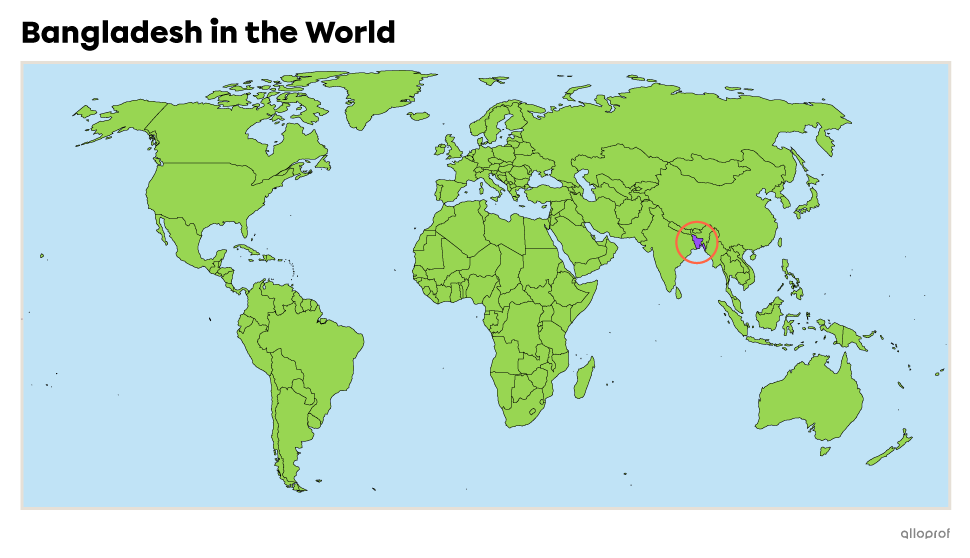To access the other sheets in the Tools in Geography module, consult the See Also section.
A country's level of development is linked above all to its wealth and the living conditions of its population. There are two main levels of development:

The majority of developing countries are in the Southern Hemisphere while the majority of developed countries are in the Northern Hemisphere.
Source: United Nations Development Programme, 2019[1].
Developed countries are found mainly in Europe and North America. Australia and Japan, located in Oceania and Asia, are also developed countries. They are industrialized countries with more wealth (money) than developing countries. The population of these countries enjoys a higher standard of living. They have access to education, which enables them to hold a wider variety of jobs. They also have access to health care. Life expectancy for people living in developed countries is generally high, meaning that people live long lives. In 2020, the average life expectancy in developed countries was 80 years of age[2].
-
The term industrialized defines a territory with several industries that exploit raw materials, transform them and produce goods.
-
Standard of living reflects the quantity of goods and services to which a person or population has access.
-
Life expectancy measures the average number of years lived by the male and female inhabitants of a country.
Canada is a developed country. It is home to many industries, from timber harvesting and processing to motor vehicle manufacturing. The service sector also has a strong presence, thanks in part to financial activities, numerous banks and information technology companies.

Every province and territory in Canada has its own education system. Children's education is compulsory. Students attend primary and secondary school. They can then go on to post-secondary education. People spend an average of 16 years in school[3].

It is one of Canada's leading universities and is recognized worldwide for its research.
Source: EQRoy, Shutterstock.com
Health care in Canada is provided by numerous hospitals and health centres across the country. There are 2.44 doctors for every 1000 people.[3] Public health insurance plans (in the provinces and territories) cover the cost of care, ensuring that residents have free access to medical and hospital services. Hospitals, such as Toronto's SickKids Children's Hospital or CHU Sainte-Justine in Montreal, specialize in the treatment of certain illnesses in children.
Life expectancy in Canada in 2020 was 81.75 years, which is similar to life expectancy in other developed countries.[4]

This hospital is one of many specialized hospitals in Canada.
Source: JHVEPhoto, Shutterstock.com
Developing countries are found mainly in South America, Africa and Asia. These countries are not highly industrialized, or are in the process of becoming so. Residents of these countries have a lower standard of living than those of developed countries. Access to education and health care is generally more limited.
A developing country may still be largely industrialized. However, its population's lower standard of living and high levels of inequality mean that it is still considered a developing country.
Bangladesh is a developing country. Its economy is based on garment manufacturing, rice cultivation and service industries. However, development is hampered by a lack of infrastructure, political instability, corruption and insufficient access to energy sources.

Primary and some secondary education in Bangladesh is compulsory and free of charge. The education system is run by the government. Nevertheless, access to education remains difficult for some portions of the population, due in part to a lack of qualified teachers and school infrastructure. In some cases, the quality of education is inadequate. For example, the literacy rate
(the proportion of people over the age of 15 who can read and write) is 74.9%.[5] That's around a quarter of the population who can't read and write.
Access to health care varies greatly between rural and urban dwellers, since cities have more health care facilities. Poverty is another factor that limits access to health care, because people have to pay for their own health care. Added to this is a shortage of doctors and health care workers in general. In 2020, there were only 0.67 doctors for every 1 000 inhabitants.[5] All this means that the quality of care in Bangladesh is lower than in many Asian countries.
Life expectancy for the population is 74.7 years.[5] This is lower than life expectancy in developed countries.
An infrastructure is a human construction or set of constructions (roads, bridges, buildings, aqueducts, etc.) that help to develop a territory.
| Indicator | Developed countries | Developing countries |
|---|---|---|
| Industrialized | Yes | No or in progress |
| Standard of living | High | Low |
| Access to education | Easier | More difficult |
| Access to health care | Easier | More difficult |
| Life expectancy | High | Low |
*This table presents a general portrait of country characteristics. |
||
An imbalance occurs when there are inequalities between different elements (people, countries, etc.).
Because developed countries have more money than developing ones, it's easier for them to tackle various issues and implement solutions. The knowledge and financial resources of these countries make it easier for them to build infrastructures adapted to their needs, or to implement measures to help their populations. For example, a developed country can more easily find and implement new ways of supplying drinking water to the cities in its territory. It can also construct buildings that are more resistant to earthquakes.
To access the rest of the unit, consult the Tools for Geography concept sheet.
1. Programme des Nations Unies pour le développement. (2019). Rapport sur le développement humain 2019. https://www.un-ilibrary.org/content/books/9789210044974/read
2. Perspective Monde. (n.d.). Espérance de vie à la naissance (année) 2020. https://perspective.usherbrooke.ca/bilan/servlet/BilanEssai/3/SP.DYN.LE00.IN/2020/2/x//sans/sansLogUni/Vert/11px/?
3. Central Intelligence Agency. (2022, July 1). Canada. The World Factbook. https://www.cia.gov/the-world-factbook/countries/canada/
4. Perspective Monde. (n.d.). Espérance de vie à la naissance (année), Canada. https://perspective.usherbrooke.ca/bilan/servlet/BMTendanceStatPays?langue=fr&codePays=CAN&codeStat=SP.DYN.LE00.IN&codeTheme=3
5. Central Intelligence Agency. (2022, July 1). Bangladesh. The World Factbook. https://www.cia.gov/the-world-factbook/countries/bangladesh/
